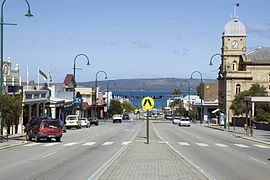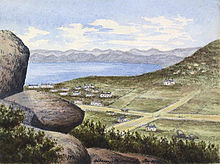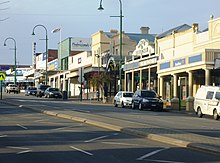
Back ألباني (أستراليا) Arabic البانى (بلده فى سيتى اوف البانى) ARZ Albany (Australia occidental) AST Олбані (Заходняя Аўстралія) Byelorussian Albany (Austràlia Occidental) Catalan Албани (гӀала) CE Albany (lungsod sa Ostralya, State of Western Australia, Albany) CEB ئاڵبانی، ڕۆژاوای ئوسترالیا CKB Албани (хула) CV Albany, Gorllewin Awstralia Welsh
| Albany Kinjarling (Nyungar) Western Australia | |||||||||
|---|---|---|---|---|---|---|---|---|---|
 York Street in Albany | |||||||||
| Coordinates | 35°01′22″S 117°52′53″E / 35.022778°S 117.881389°E | ||||||||
| Population | 35,053 (2021)[1] (44th) | ||||||||
| • Density | 117.944/km2 (305.47/sq mi) | ||||||||
| Established | 26 December 1826 | ||||||||
| Postcode(s) | 6330 | ||||||||
| Elevation | 26 m (85 ft) | ||||||||
| Area | 297.2 km2 (114.7 sq mi)[2] (2011 urban) | ||||||||
| Time zone | AWST (UTC+8) | ||||||||
| Location | |||||||||
| LGA(s) | City of Albany | ||||||||
| State electorate(s) | Albany | ||||||||
| Federal division(s) | O'Connor | ||||||||
| |||||||||





Albany (/ˈælbəni/ AL-bən-ee;[a][3] Nyungar: Kinjarling) is a port city in the Great Southern region in the Australian state of Western Australia, 418 kilometres (260 mi) southeast of Perth, the state capital. The city centre is at the northern edge of Princess Royal Harbour, which is a part of King George Sound. The central business district is bounded by Mount Clarence to the east and Mount Melville to the west. The city is in the local government area of the City of Albany. While it is the oldest colonial, although not European,[b] settlement in Western Australia — predating Perth and Fremantle by over two years — it was a semi-exclave of New South Wales for over four years until it was made part of the Swan River Colony.
The settlement was founded on 26 December 1826 as a military outpost of New South Wales for the purpose of forestalling French ambitions in the region.[4]: 61 To that end, on 21 January 1827, the commander of the outpost, Major Edmund Lockyer, formally took possession for the British Crown of the portion of New Holland not yet claimed by the Crown; that is, the portion west of the 129th meridian east, with the portion east already being claimed collectively by the Crown as New South Wales and Van Diemen's Land.[5] During the last decade of the 19th century, the town served as a gateway to the Eastern Goldfields. For many years, it was the colony's only deep-water port, having a place of eminence on shipping services between Britain and its Australian colonies. The opening of the Fremantle Inner Harbour in 1897,[6]: 51–55 however, saw its importance as a port decline, after which the town's industries turned primarily to agriculture, timber and later, whaling.
Contemporary Albany is the southern terminus for tourism in the region, and the state's south west,[7] which is known for its natural environment and preservation of its heritage. The town has a role in the ANZAC legend, being the last port of call for troopships departing Australia in the First World War. On 1 November 2014, the Australian and New Zealand Prime Ministers opened the National Anzac Centre in Mount Clarence, Albany, to commemorate 100 years since the first ANZAC troops departed from King George Sound. Approximately 40,000 people attended the commemoration events held between 30 October and 2 November 2014.[8]
An auxiliary submarine base for the US Navy's 7th Fleet was developed during the Second World War in the event the submarine base at Fremantle was lost. Also in the harbour was a Royal Australian Navy naval installation which provided for refuelling from four 5,100-tonne (5,000-long-ton) fuel tanks.[9]: 26
- ^ Australian Bureau of Statistics (28 June 2022). "Albany". 2021 Census QuickStats. Retrieved 4 May 2023.
- ^ "2011 Census Community Profiles: Albany". ABS Census. Australian Bureau of Statistics. Retrieved 15 September 2016.
- ^ Groundwater, Ben (29 March 2023). "Eight Australian places we keep pronouncing incorrectly". Traveller. Retrieved 31 March 2023.
- ^ Battye, James Sykes (2005) [1924]. Western Australia: A History from its Discovery to the Inauguration of the Commonwealth. Oxford: Clarendon Press. OCLC 4362013. Retrieved 24 September 2021 – via Project Gutenberg of Australia.
- ^ "King George's Sound Settlement". State Records. State Records Authority of New South Wales. Archived from the original on 24 June 2014. Retrieved 23 September 2021.
- ^ Hutchison, David (2006). Fremantle Walks. Fremantle: Fremantle Arts Centre Press. ISBN 1-921064-30-7. OCLC 86110696.
- ^ "Destination Albany". Retrieved 7 October 2017.
- ^ "Anzac Albany | National Anzac Centre". www.nationalanzaccentre.com.au. Retrieved 15 February 2020.
- ^ Commander Seventh Fleet (15 September 1944). Base Facilities Report (Report). United States Navy. Retrieved 26 September 2021.
Cite error: There are <ref group=lower-alpha> tags or {{efn}} templates on this page, but the references will not show without a {{reflist|group=lower-alpha}} template or {{notelist}} template (see the help page).
